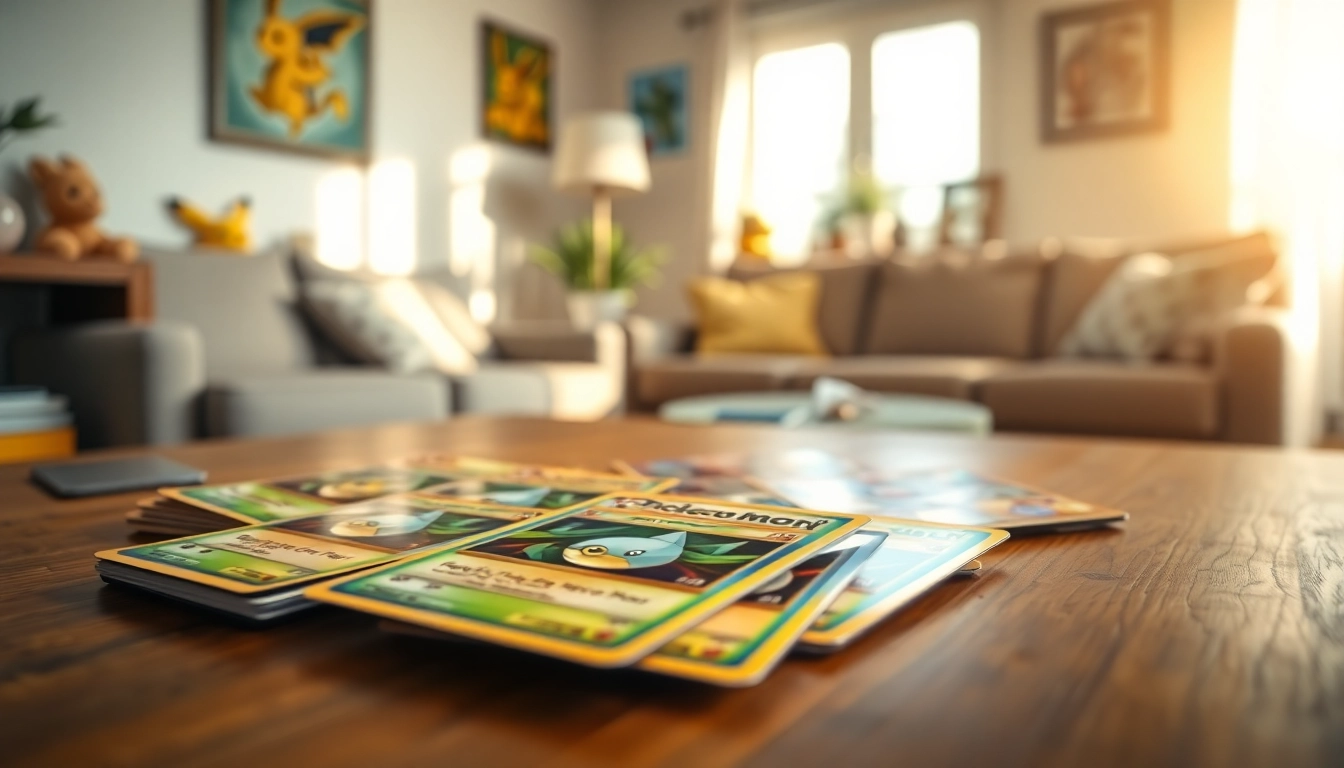Understanding Real Pokemon Cards
The world of Pokémon cards has long captivated collectors and enthusiasts alike. As each new generation of trainers emerges, the demand for real pokemon cards continues to rise, making it crucial for collectors to educate themselves about the authenticity of these cherished items. Understanding the nuances of what defines a real Pokémon card is fundamental not just to avoid counterfeits, but also to appreciate the investment value of these cards.
Characteristics of Authentic Cards
Identifying a genuine Pokémon card involves recognizing several distinguishing characteristics:
- Print Quality: Authentic Pokémon cards boast high-quality printing. The artwork should appear sharp and vibrant, with colors that are true to the original designs. Blurriness or faded colors are immediate red flags.
- Card Stock: Real Pokémon cards are made from a specific type of cardstock that has a particular feel and weight. Genuine cards are durable and have a slight gloss finish.
- Textual Elements: Authentic cards have perfectly aligned text, accurately printed fonts, and correct spellings. Check terms like “Pokémon”, “Stage 2”, and other card-specific jargon for accuracy.
- Holographic Features: Many cards, especially rare ones, include holographic elements that change when viewed from different angles. A counterfeit will often lack this complexity.
- Feel: Genuine cards feel smooth to the touch and are not overly thick or thin. If you hold it and something seems off in texture, it’s worth double-checking.
Common Misconceptions
Many new collectors fall prey to common misconceptions that can lead them to purchase fake cards:
- All Vintage Cards Are Valuable: While some older cards are invaluable, not all have significant worth. Condition, rarity, and demand ultimately govern value.
- Holographic Equals Valuable: Just because a card has a holographic finish does not mean it is worth more; rarity and demand are what determine price.
- Packing Style Indicates Authenticity: The way a card is packed does not always guarantee authenticity. Always inspect the card itself independently.
Variations in Card Rarity
Not all Pokémon cards are created equal. The Pokémon Trading Card Game (TCG) uses a variety of classifications to determine rarity. Understanding these categories helps collectors maximize their investments:
- Common Cards: These are widely available and usually feature basic Pokémon. They are the least valuable.
- Uncommon Cards: Slightly harder to find than common cards, they may include special abilities that make them more desirable.
- Rare Cards: These cards are less frequently printed and are often sought after by collectors.
- Ultra Rare and Secret Rare: This category includes cards with unique designs or features, making them highly valued in the collector’s market.
Where to Purchase Real Pokemon Cards
Now that you understand the attributes of authentic cards, the next step is knowing where to find them. With countless vendors online, in addition to local game stores, it’s vital to choose wisely to avoid scams.
Top Online Retailers
When searching for real Pokémon cards online, several premier retailers have established their reputation:
- Pokémon Center: The official Pokémon site offers a variety of TCG products including booster packs, elite trainer boxes, and more. Their cards are assured to be legitimate.
- TCGPlayer: This platform allows users to buy individual cards from various sellers. Always check seller ratings for reliability.
- Amazon: While it offers a vast selection, be cautious—verify seller ratings and reviews to ensure card authenticity.
Local Game Stores
Visiting your local game store can offer unique advantages:
- Physical Inspection: One can inspect the cards personally, mitigating the risk of purchasing faux cards.
- Community Connections: Local stores often host events and tournaments—engaging with the community can yield valuable insights and connections.
- Expert Recommendations: Staff members are usually well-versed in card details and can guide you toward reputable collections.
Marketplace Tips
Utilizing online marketplaces can be an effective avenue for purchasing real Pokémon cards. Here are tips to maximize your success:
- Use Trusted Platforms: Opt for well-known platforms with buyer protection policies.
- Ask for Proof of Authenticity: When purchasing from individuals, request high-resolution images and even certifications, if applicable.
- Beware of Deals Too Good to Be True: If a deal appears too cheap, it’s often a sign of counterfeit items.
Identifying Fake Pokemon Cards
Unfortunately, the market is saturated with counterfeit Pokémon cards. Learning how to identify fakes will protect your investment and enhance your collecting experience.
Visual Inspection Techniques
Conducting a thorough visual inspection is critical. Here are techniques to scrutinize your cards:
- Light Test: Hold the card up to a light source. Genuine cards are usually printed in a way that they let some light through but will not be fully translucent.
- Black Light Test: Under a black light, authentic cards should exhibit specific refractive properties while forgeries may not. Knowing how each card should look in this light is essential.
- Edge Comparison: Genuine cards have clean, uniform edges, whereas counterfeit ones may show signs of poor cutting and finishing.
Using Tools for Verification
Sometimes, manual checks are not enough, and specific tools can enhance verification quality:
- Magnifying Glass: Inspect the print quality closely. Authentic cards have a specific dot pattern known as “rosette” printing.
- Counterfeit Detector Apps: Some apps are designed to check the authenticity of trading cards by scanning barcodes or analyzing images.
Community Resources for Assistance
Relying on the community can provide valuable insights in identifying fakes:
- Forums and Discord Groups: Online platforms often have dedicated sections for card authenticity where seasoned collectors share tips.
- Social Media Communities: Platforms like Reddit have dedicated threads discussing counterfeit identification. Engaging with these communities can offer helpful strategies.
The Value of Real Pokemon Cards
The financial allure of Pokémon cards is a significant factor for many collectors. Understanding the nuances surrounding their values can be especially beneficial.
Factors Influencing Resale Value
Several key factors influence the worth of a Pokémon card in the resale market:
- Condition: Cards rated higher on the PSA (Professional Sports Authenticator) scale typically command higher prices.
- Rarity: As discussed, cards that belong to limited sets or are classified as ultra-rare may appreciate significantly over time.
- Demand: Market interest fluctuates; cards featuring popular Pokémon characters will see higher demand.
Market Trends and Predictions
The Pokémon card market is dynamic, and emerging patterns can help collectors make informed purchases:
- Growing Popularity of Vintage Cards: Nostalgia effects drive interest, and as older cards circulate less frequently, their value can significantly increase.
- Influence of Media Exposure: New Pokémon games, shows, or movies can spike interest in specific card types or characters.
- Investment vs. Collection: Many collectors view cards both as collectibles and investments, leading to unique market behavior.
Collecting for Investment vs. Passion
Collecting Pokémon cards can be an investment strategy, but it can also be driven by passion:
- Investment Strategy: Investors may choose to buy cards based on rarity and market trends, holding them for long-term appreciation.
- Passionate Collecting: Many collectors derive joy from assembling complete sets, focusing on personal attachment rather than potential future worth.
Engaging with the Pokemon Card Community
Being part of the Pokémon community can enhance your collecting experience, providing mentorship, trading opportunities, and friendships.
Joining Local Clubs and Online Forums
Becoming a member of local or online communities allows you to network with fellow collectors:
- Local Clubs: Many communities host clubs where members can share strategies, insights, and opportunities for trades.
- Online Forums: Digital platforms provide a vast resource pool, where discussions around authenticity, market trends, and collecting tips are common.
Participating in Trading Events
Trading events are a staple in the Pokémon community and supply excellent opportunities to engage with other collectors:
- Meet New Collectors: Trading events can introduce you to new friends and trading partners who share your enthusiasm.
- Showcase Skills: These events allow you to demonstrate your collection and learn from others, expanding your knowledge.
Building Your Collection Intentionally
Building a well-rounded Pokémon card collection requires intention:
- Set Goals: Identify what you want to achieve. Whether it’s a complete set or a focus on rare cards, having clear goals will guide you.
- Prioritize Quality Over Quantity: It’s tempting to acquire lots of cards, but investing in quality pieces is more beneficial in the long run.



